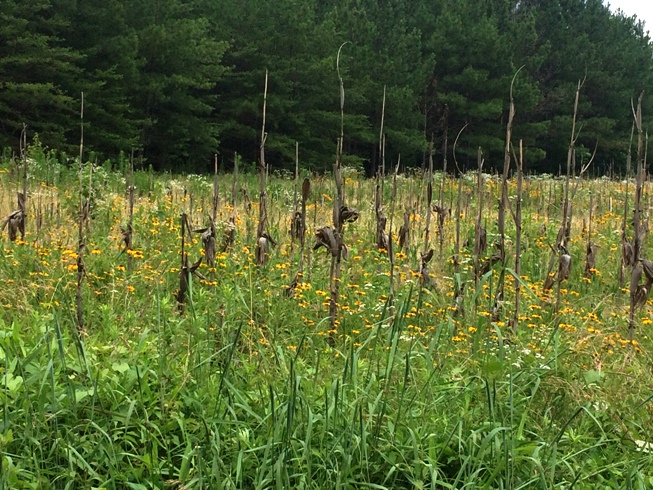
This is a true story about a man devoted to quail management. I won’t give his name or tell you exactly where his property is other than – it’s in Central Virginia. About a decade ago he began managing a 60-acre tract. His property truly represents maximizing habitat work. He has sought advice from many professionals. Most importantly, he took action. His farm is a showcase and he has from 2 to 4 coveys on that 60 acres year in and year out (don’t let anyone say you cannot contribute to quail recovery on small acreages – it is possible, but depends at least in part on what types of lands surround your land). Over the years he expanded his landholdings, his management and his quail population. His main goal is not hunting quail, though he does like to have a hunt or two each year.
Last year he approached me about a new tract of land he was thinking of buying a few miles from his existing property. He wanted my opinion on its “quail potential.” I met him and as we drove into the property I thought to myself “someone is already managing this land intensively for quail.”
The pines had been thinned substantially, in some places almost down to what we call “quail density,” about 40 to 50 square feet of basal area per acre. All the logging roads had been widened with nice sunlight getting in along the 30-to-50- foot expansions on both sides of the roads. It appeared multiple logging decks had been used when thinning this tract and each had been expanded into small clearings of an acre or more and already planted with legumes. A lot of the hardwood encroachment had been controlled in the understory mechanically. All that was really left to do was start a burning regimen in the pines (which has since been done), and a combination of a liming, fertilization and discing regimen on the clearings … and he’d have 200 acres of prime quail cover.
“Who has been managing this land for quail?” I asked. He grinned and said “No one, this is a failed housing development project.”
It made perfect sense then. The roads had been widened to accommodate increased vehicle traffic and paving. The small clearings were to be house lots. Enough pines had been left to provide some aesthetics and shade for new homes. I don’t know whose development it was, and I feel bad for them. I don’t want to be accused of making light of anyone’s bad luck. But for the quail on this area, their misfortune was a boon. It also made me realize that maybe I should consider new ways in which to describe “quail cover” – picture a new 5-10 acre average lot size housing development in a piney woods area without the houses, lawns and pavement. By the way, when the owner allowed a good bird dog man to hunt the tract for the first time this past winter, they found five coveys of quail in a few hours – further proof to me that quail do find new habitats and can do well in them.
In a recent article in Quail Forever Magazine by Tall Timbers Research Station researchers Clay Sisson and Dr. Theron Terhune presented evidence on how important managed clearings can be within a pine ecosystem as quail brood-rearing cover. I suggest you visit their website for more information and consider supporting their organization and subscribing to their e-newsletter (http://talltimbers.org/welcome-to-tall-timbers/ ).

Primarily, they found that these clearings made superior brood-rearing cover compared to either burned or unburned thinned pine stands under poor or acidic soil conditions. The main reason – properly managed clearings produced far more insects than surrounding pine stands. I followed up with Dr. Terhune by e-mail and he provided me this information: “The need for brood fields and the proportion of fields required is dictated by soil type. Basically, the lower the soil quality the higher the percentage of fields needed. In very low quality soils we recommend 25-30% fields. Average desirable field size is 1.5 to 2 acres and should range from 1 – 4 acres and not larger than 5 acres. However, in higher quality soils burned piney woods often provide adequate brood-rearing habitat.”
In many parts of Virginia’s coastal plain, the soils are either sandy, which means they do not hold nutrients very well, or they are acidic. Likewise, many soils in the piedmont, though heavier than coastal plains soils, can be very acidic. This varies by site. The main lesson is to get to know the soils on your land. You can contact an NRCS soil conservationist at your local USDA Service Center for more information on your land’s soil.
Further reading of their articles led me to other findings such as how the quality of these fields tends to decline over time. There may be some need for liming and fertilization which can be expensive. Most recently the staff of TTRS has experimented with using rotational agricultural plantings and incorporation of legumes to “rebuild” these fields, as opposed to fertilization. As with all quail management, the key is rotation. The fields can be rotationally disced, or rotationally planted with agricultural crops or legumes. The key is not planting the entire field every year. There is nothing that makes brood-rearing cover quicker than fallowed crop lands.
What should you do? First, get to know your soils, have soil tests done on clearings and lime and fertilize according to recommendations to start. There are many ways to approach soil testing, but the best in my opinion is via your local Cooperative Extension Service. You can decide on how many fields, and whether to use planted crops or simple rotational discing based on your time and budget. If you do not think your burned piney woods are producing quail like they should, check the soils and consider incorporating multiple brood clearings.


